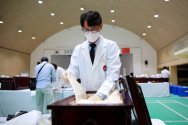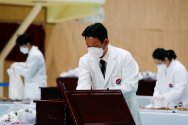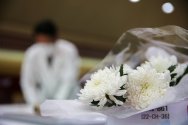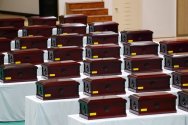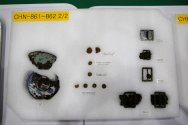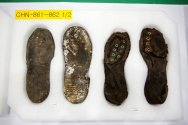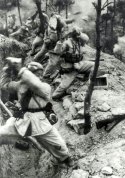You are using an out of date browser. It may not display this or other websites correctly.
You should upgrade or use an alternative browser.
You should upgrade or use an alternative browser.
Korean War 70 years later Win Lose and A draw
- Thread starter TerraN_EmpirE
- Start date
Wasn't it the case American POWs willingly wanted to defect to China and the US higher ups couldn't believe it. They thought those men were being brainwashed which was also the basis of the Hollywood movie, Manchurian candidate?View attachment 96288
Chinese Volunteer Soldier guards African American POWs with his M3 submachine gun, Second Phase Offensive
View attachment 96289
Chinese Volunteer Soldier guards African American POWs with his M3 submachine gun, Second Phase Offensive
View attachment 96290
This picture shows African American serviceman, Private First Class James Wilson, shaking hands with his Chinese Communist captors. This cover is part of a pamphlet created by the KPA and PVA, Here is an excerpt of the text:
The leaflet goes on to report lynchings and crimes against black men both in the United States and in the U.S. Army in Korea. It discusses politics in the United States and points out how few black Congressmen and Senators hold office. It reminds the black soldiers of how few black officers have been commissioned in the military.
I do know of one black american POW who defected and started a family in China once the Korean War ended so it could be possible.Wasn't it the case American POWs willingly wanted to defect to China and the US higher ups couldn't believe it. They thought those men were being brainwashed which was also the basis of the Hollywood movie, Manchurian candidate?
The Battle of Hoengsong was one of the most devastating defeats U.N forces had been dealt during the Korean War.
In early February, with the Chinese offensive stalled, U.N. commanders prepared a counter assault across the center of the Korean peninsula. This time, however, Republic of Korea (ROK) troops were to do the bulk of the fighting -- with elements of various U.S. infantry, artillery and other units supporting them. The notion of Americans supporting ROK troops was very much an experiment -- one U.S. military leaders later regretted.
What U.N. commanders didn't know was that Communist forces also were launching a major offensive and had moved four Chinese and two North Korean divisions into the area north of the village of Hoengsong. On Feb. 11, ROKs tangled with Chinese Communist forces, quickly disintegrating the planned South Korean offensive. American GIs encamped for the night, relying on ROK infantry for protection. When the Chinese attacked in the dark, the South Koreans fled. The Chinese decimated U.S positions in a brutal massacre.
Here are some American veteran's descriptions of the horror at Hoengsong:
"After we were released we started walking that night and got away from that village, which wasn't too far from where we had been captured. It was another moonlight night. As we walked on the road, we came upon a bunch of dead bodies that were frozen stiff. Hundreds of them. Untold hundreds of them laying there. We didn't know that they had been killed in a massacre, but when we saw all those bodies we knew that something terrible had happened to them. It's only recently that I have begun to find something out about it. I never thought I would ever find out. Why does our government try to cover up certain things? They covered up the Hoengsong Valley Massacre. I was there. I saw the dead bodies." -- (William Dewey Freeman)
"On March 7, W/2/7 was advancing along with the rest of the 2nd Battalion of the 7th Marines to new positions in East Central Korea near the little village of Hoengsong. We had been on the move for two or three hours on foot when we spotted some American bodies along the road out in a rice paddy. Then we saw another and another, some closer to the road. As we walked on, more bodies showed up. We had no warning. Then on the road we came upon a military truck with Army markings. Checking further, we saw four frozen bodies in the truck--all American soldiers, then more trucks and tanks. We started seeing bodies all over by the hundreds. Some of them were burned and naked. For every ten American bodies we saw there was one Chinese body. Government records show that about 700 Army personnel were killed and maybe executed in this narrow valley. Army records show that 2,018 American and Dutch were killed there February 11-13, 1951. One hundred of the victims were Dutch. Also lost in this valley were fourteen 105mm Howitzers, six 155mm Howitzers, six tanks and 280 vehicles of various types. It is believed that the Chinese forces used some of this captured equipment against us soon thereafter.
A write-up of this action was written by Gary Turbak and published in the VFW Magazine in February 2001. He wrote: "The grisly scene, horrible almost beyond belief, shocked even the toughest men of the 7th Marine Regiment. Some averted their eyes. Others broke off their macho banter to talk in hushed church-like tones." -- (Dale Erickson)
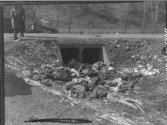
Hongseong, UN soldiers corpses scattered in the waterway.
In early February, with the Chinese offensive stalled, U.N. commanders prepared a counter assault across the center of the Korean peninsula. This time, however, Republic of Korea (ROK) troops were to do the bulk of the fighting -- with elements of various U.S. infantry, artillery and other units supporting them. The notion of Americans supporting ROK troops was very much an experiment -- one U.S. military leaders later regretted.
What U.N. commanders didn't know was that Communist forces also were launching a major offensive and had moved four Chinese and two North Korean divisions into the area north of the village of Hoengsong. On Feb. 11, ROKs tangled with Chinese Communist forces, quickly disintegrating the planned South Korean offensive. American GIs encamped for the night, relying on ROK infantry for protection. When the Chinese attacked in the dark, the South Koreans fled. The Chinese decimated U.S positions in a brutal massacre.
Here are some American veteran's descriptions of the horror at Hoengsong:
"After we were released we started walking that night and got away from that village, which wasn't too far from where we had been captured. It was another moonlight night. As we walked on the road, we came upon a bunch of dead bodies that were frozen stiff. Hundreds of them. Untold hundreds of them laying there. We didn't know that they had been killed in a massacre, but when we saw all those bodies we knew that something terrible had happened to them. It's only recently that I have begun to find something out about it. I never thought I would ever find out. Why does our government try to cover up certain things? They covered up the Hoengsong Valley Massacre. I was there. I saw the dead bodies." -- (William Dewey Freeman)
"On March 7, W/2/7 was advancing along with the rest of the 2nd Battalion of the 7th Marines to new positions in East Central Korea near the little village of Hoengsong. We had been on the move for two or three hours on foot when we spotted some American bodies along the road out in a rice paddy. Then we saw another and another, some closer to the road. As we walked on, more bodies showed up. We had no warning. Then on the road we came upon a military truck with Army markings. Checking further, we saw four frozen bodies in the truck--all American soldiers, then more trucks and tanks. We started seeing bodies all over by the hundreds. Some of them were burned and naked. For every ten American bodies we saw there was one Chinese body. Government records show that about 700 Army personnel were killed and maybe executed in this narrow valley. Army records show that 2,018 American and Dutch were killed there February 11-13, 1951. One hundred of the victims were Dutch. Also lost in this valley were fourteen 105mm Howitzers, six 155mm Howitzers, six tanks and 280 vehicles of various types. It is believed that the Chinese forces used some of this captured equipment against us soon thereafter.
A write-up of this action was written by Gary Turbak and published in the VFW Magazine in February 2001. He wrote: "The grisly scene, horrible almost beyond belief, shocked even the toughest men of the 7th Marine Regiment. Some averted their eyes. Others broke off their macho banter to talk in hushed church-like tones." -- (Dale Erickson)

Hongseong, UN soldiers corpses scattered in the waterway.
"Weapons of the Volunteers"
The PLA has been well known for its vast arsenal of weapons from all different types of backgrounds, American, German, Japanese, Soviet, etc... Here are some photos of the Korean War that showcase some unique weapons in the Volunteer's arsenal.
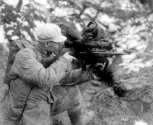
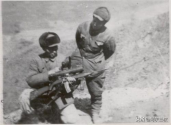
Volunteer Soldiers pose with a captured U.S M1. 30 Infrared Caliber Carbine. The first infrared sniper-scope was deployed in Korea, however the M1 IR had poor range and the IR source was easily damaged. Few combat personnel in the Korean War were aware that the US possessed infrared night-vision capability. Those who did know, didn't welcome them. Objections were mostly focused on their bulk and susceptibility to damage.
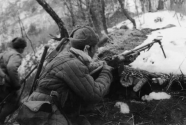
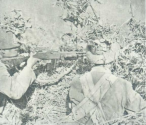
Volunteers use captured American M1918 Browning Automatic Rifles.
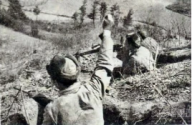
Volunteers use Japanese Type 96 light machine guns.
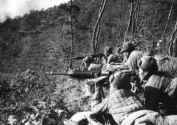
Chinese Volunteers use Japanese Type 92 Machine Guns.
The PLA has been well known for its vast arsenal of weapons from all different types of backgrounds, American, German, Japanese, Soviet, etc... Here are some photos of the Korean War that showcase some unique weapons in the Volunteer's arsenal.


Volunteer Soldiers pose with a captured U.S M1. 30 Infrared Caliber Carbine. The first infrared sniper-scope was deployed in Korea, however the M1 IR had poor range and the IR source was easily damaged. Few combat personnel in the Korean War were aware that the US possessed infrared night-vision capability. Those who did know, didn't welcome them. Objections were mostly focused on their bulk and susceptibility to damage.


Volunteers use captured American M1918 Browning Automatic Rifles.

Volunteers use Japanese Type 96 light machine guns.

Chinese Volunteers use Japanese Type 92 Machine Guns.
"Not just Yanks"
"They kept the blacks separate from the whites. They also kept the Turks and English separate from everybody else. We joked about the camp and called it the United Nations camp." - How an American Korean War veteran, Glenn Scotts, describes a Chinese POW camp.
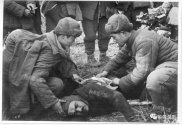
Chinese Volunteer Medics treat an injured Turkish Soldier
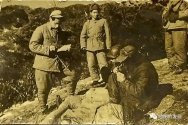
Chinese Soldiers interrogate two Canadian Soldiers.
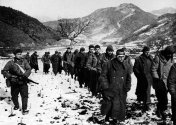
Chinese Soldiers escorting a mixture of American and Turkish POWs.
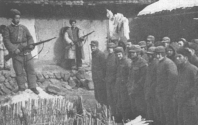
British POWs of the 29th Infantry Brigade are guarded by Chinese Volunteer Soldiers. It is worth mentioning that this annihilated British Royal Tank Battalion, formerly the British 18th Irish Regiment, slaughtered civilians in Guangzhou, Dinghai, Zhenjiang and other places during the Opium War. This regiment once recorded the Battle of Zhenjiang: "The Chinese were burning like firecrackers one by one" , and some veterans even said the smell in the air was like roast duck.
When the Chinese 50th Army wiped them out on the Korean battlefield, the Volunteer veteran recalled: "British tanks exploded one by one."
From the Chinese burning like firecrackers one by one, to British tanks exploding one by one.
This battle is called the Battle of the Happy Valley in English.
"They kept the blacks separate from the whites. They also kept the Turks and English separate from everybody else. We joked about the camp and called it the United Nations camp." - How an American Korean War veteran, Glenn Scotts, describes a Chinese POW camp.

Chinese Volunteer Medics treat an injured Turkish Soldier

Chinese Soldiers interrogate two Canadian Soldiers.

Chinese Soldiers escorting a mixture of American and Turkish POWs.

British POWs of the 29th Infantry Brigade are guarded by Chinese Volunteer Soldiers. It is worth mentioning that this annihilated British Royal Tank Battalion, formerly the British 18th Irish Regiment, slaughtered civilians in Guangzhou, Dinghai, Zhenjiang and other places during the Opium War. This regiment once recorded the Battle of Zhenjiang: "The Chinese were burning like firecrackers one by one" , and some veterans even said the smell in the air was like roast duck.
When the Chinese 50th Army wiped them out on the Korean battlefield, the Volunteer veteran recalled: "British tanks exploded one by one."
From the Chinese burning like firecrackers one by one, to British tanks exploding one by one.
This battle is called the Battle of the Happy Valley in English.
Last edited:
Recent events convinced me that the participation in the Korean war is most correct decision the PRC had ever made , it single handedly secured modern China against any land invasion for at least a century or two. Even during the most chaotic days and the most underfunded decade of the PRC, no one really considered invading China on land precisely because of the Korean war.
I kept hearing how Euro and Anglo clowns think none of the troubles today would have happened had they just attacked the USSR after Germany's defeat, let's forget the fact they'll almost certainly lose since they aren't half as good as fighting as they think they are and most of their confidence are just surrendered Nazi officers fondling their cock.
Not one of them are any less greedy and trigger-happy than 200 years ago and it would be utter stupidity to have even one of their jackboots share a common land border with China. I wouldn't doubt that they would be talking about it in the exact same matter if not for China's participation in the Korean War because good god do they need a reality check.
I kept hearing how Euro and Anglo clowns think none of the troubles today would have happened had they just attacked the USSR after Germany's defeat, let's forget the fact they'll almost certainly lose since they aren't half as good as fighting as they think they are and most of their confidence are just surrendered Nazi officers fondling their cock.
Not one of them are any less greedy and trigger-happy than 200 years ago and it would be utter stupidity to have even one of their jackboots share a common land border with China. I wouldn't doubt that they would be talking about it in the exact same matter if not for China's participation in the Korean War because good god do they need a reality check.
Serves as a good lesson for the future when we take back taiwan. Indians are snakes and won't hesitate to fuck us over whenever they smell a hint of weakness. Though, I want to see them try that border move once more during then, would be a good excuse to end this once and for all.One consequences of Korean war is that china lost Tawang to india when indian army marched there and removed tibbetian official in 1951. China was busy in Korean war and still they couldn't able to seize Tawang in 1962 war with india.

